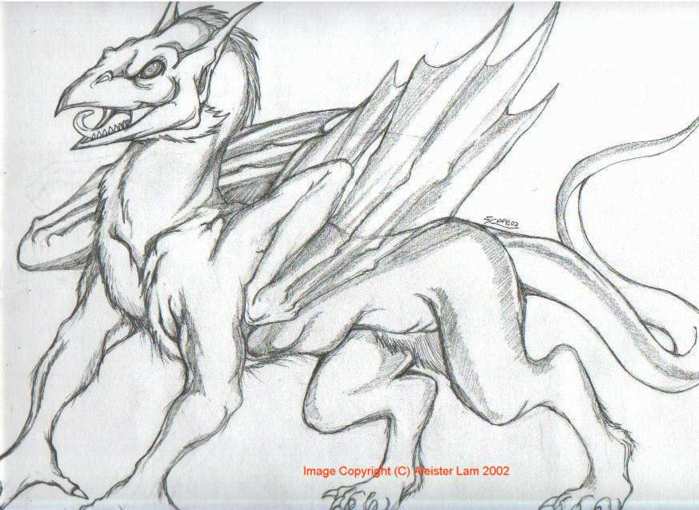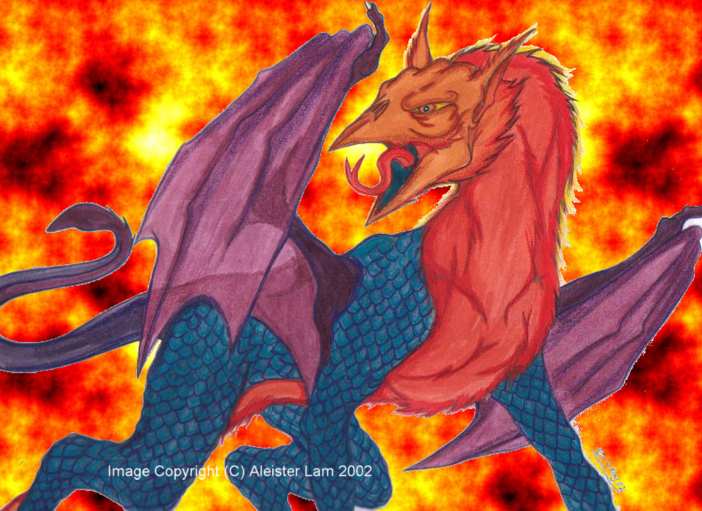|
|
|
|
Original Artworks for the Monsters in this Gallery are : Copyright(C) Aleister Lam 2002 |
|
|
|
|
| Gryphon Variation : The Egyptian Sefert The classic case of good versus evil is depicted in the ancient Egyptian story of Osiris, one of their most important deity. Initially Osiris is the god of agriculture and he married the goddess Isis and is the father of Horus and the dog headed, Anubis. Osiris is said to be the very first egyptian god to be born to the earth and it was then followed by his brother Seth. The brothers split the land of Egypt into two, Osiris would rule over lower Egypt while Seth was the ruler of Upper Egypt. Osiris was gifted in his knowledge of agriculture and skilled in geology, he was able to breathe live to this barren land and created a condusive environment for growing crops. His effort in educating the people of his land enable lower Egypt to prospered and flourished as a land of abundance in food and water. Seth on the other hand was not as successful and was getting increasingly jealous of his brother's success. Many peasants moved Northward towards Orisis's land in an effort to improve their lives as Upper Egypt is getting increasingly barren and food is getting scarce as everyone there relied on huntings. Seth's jealousy turned to hatred and he devised a ploy to get rid of Osiris. He obtained an exact measurement of Osiris's body and commanded the best artisan of the land to built a chest of gold and decorated with the most precious gemstones and jewels with a one way locking mechanism. The chest was presented to Osiris on his birthday celebration and he managed to trick Osiris into trying out the chest by getting into it. Immediately Seth closed the chest and there wasa no way of opening it; the chest is specifically designed to ensure that no one would be able to opened it once its closed and the victim inside will suffocate to death. Seth and his henchmen carried off the chest and dump it into the river Nile. When Isis realised that Seth's motive was to destroy Osiris, she and her sons set out to find the body of Osiris. Isis was able to partially revived Osiris, but Seth learned of his brother's resurrection and sent an army to retrieve his wounded brother. To ensure that he would completely wipe out his brother's existence; Seth had him severed into 14 pieces and scattered into the Nile. It took much effort before Isis and his sons were able to retrieve 13 pieces of Osiris's body parts. It was at this point that they enlisted the help of the Sefert to guard the remains of Osiris. The Sefert is a vigilant guardian whose sole purpose is to protect and stand guard ensuring the enemies would not be able to come near to Osiris, while Isis and the rest seek help from Thoth, the god of Wisdom to resurrect Osiris's soul. The Egyptian Sefert was depicted as a creature with a bird-like head, probably that of a hawk with the body of a lion; a pair of bat-like wings and a serpentine tail. This description looks very much like that of a gryphon and this is why I classified it under Gryphon variations. Very few informations can be found about the Egyptian Sefert; this is the only info. I have. |
 |
 |
Gryphon Variation : Pyrippus Most people are fascinated and are aware of the heavenly horses that soar gracefully above the sky; there are people who devoted an entire passage and even an entire web-site just on the winged horse, Pegasus. Then there is the single horned mythical creature, known as the Unicorn, which have also garnered its own group of loyal supporters and fans. But little is mentioned about the horses that dwells below the earth, the stallions that reign supreme in the hellish underground. Many don't even know that there is a name given to these hellish stallions called Pyrippi ( plural ). In Greek mythology they are said to reside in the underworld and are responsible for driving the chariot of Hades. I prefer to think that the Pyrippus (singular) is a combination of various mythical horses like a body similar to the Unicorn with cloven hooves, fetlocks and manes; like Pegasus, it is also winged but instead of feathered wings, Pyrippus has a pair of bat-like wings and a barbed tail like that of a Wyvern. In traditional symbology the feathered wings of Pegasus symbolises transcendence and liberty whilst the leathery bat-like wings of the Pyrippus symbolises the perversion of the intellect towards the evil nature. These creatures while having the basic form of a horse are also reptilian by nature as they have a sleek dark purplish scaly hide. I classified them under the Gryphon variations because they have a beaked snout which is like that of a bird and a forked tongue similar to a serpent. These demonsteed are swifter in terms of flight as compared to Pegasus because of their leathery winged appendages. Their scaly hide makes them impenetratable to fire and most weapons ,their serpentine and barbed tail which is about 5 feet in length also serves to distract and swings like a defensive club in time of danger. These demonsteeds are formidable creatures as they have powerful strides and hooves that are as tough as steel that they used to trample their enemy; their powerful bird-like snout enable them to peck or ripped into the flesh of its oppressors and tearing it to pieces. If anyone have more informations about these interesting equine mythical creatures like their habitat, origins or history; would appreciate if You could email me? |
| The Wendigo There is a mythological creature in the lore of the northeastern tribes of Algonquian Indians that is oddly seemed to be a cross between a Sasquatch and a werewolf; but it should not be mistaken for a werewolf. It is said to be a human initially and that he was transformed into a fearsome, cannibalistic, beast after being forced by circumstances beyond his control causing him to regress to eating human flesh in an effort to survive the harsh conditions of the wilderness. There are many tales about hunters who are lost in the bush without food or provisions for a long time and had to regress into cannibalistic predators that prey on fellow human beings. The taste of human blood and flesh caused them to be cursed by the Manitou, spirits of the wild, and are then said to transform these former hunters into Wendigos, a creature that preys on unwary fellow human beings. Many of those who regress into animalistic behavior have found it difficult to revert to normal human behavior,exhibiting cannibalistic tendencies even after months of therapy. It is possible that such incidences, especially during the pre-colonial times when psychological therapy was non-existent, may have given rise to the myth of the mysterious transformation of normal human beings into Wendigos. Among the Ojibwa tribe, the term wendigo is used to refer to an Ogre or a sort of a hulkish troll-like creature which has often been used to |
|
| Naga Transformation This picture is one that I have nearly discarded decades ago, I found it in a badly creased and tattered conditions and decided to revive it in the hope that people who visits my gallery gets to see and comment on it.
Nagas are serpent-beings with the ability to transpose between humans and snakes. There are various beliefs and representation of the Naga race, some depict it as creatures with the upper torso of humans and lower body of huge scaly snakes. My picture chose depict otherwise! To illustrate that Nagas are not actually that bad, here's a story :
It is said that while meditating under a fig tree, the Buddha, founder of Buddhism was chastised by strong wind and heavy rain, a Naga noticed his radiance, slithers up to him and coiled around him, it raised its head over the Buddha and shielded him from the bad weather. |
|
|
|
|
|
|
|